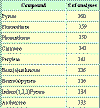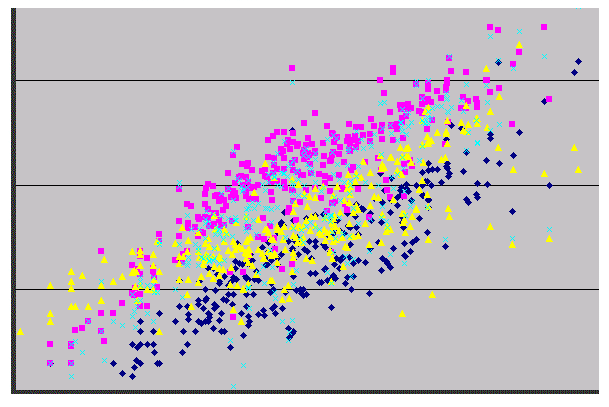
| Lake Pontchartrain Basin: Bottom Sediments and Related Environmental Resources |
Summary of Geological and Chemical Data (cont.)
Organic Components
Organic components are presented in five subtables of the database (appendix D), corresponding to major organic constituent categories as follows:
|
 Table 10 |
The frequency of occurrence of the organic constituents is recorded in table 10. Although organic constituents were analyzed in the extensive Louisiana Department of Environmental Quality resource studies of 1983-84 (Overton and others, 1984; Schurtz and St. Pé, 1984; Chew and Swilley, 1987), they were mostly below detection limits. The EMAP studies of 1991-94 (Macauley and Summers, 1998) have yielded more quantitative data on the many related congeners (organic chemical groups) utilizing more sensitive methods. The EMAP studies also provide data on biota, water column, and organism toxicity tests. These data are not included in the appendix D database but are available from USEPA at http://www.epa.gov/emap/html/dataI/estuary/data/.
| Organic constituents in generic groups, like polyaromatic hydrocarbons (PAH), often show systematic relationships when plotted on log/log scales (fig. 25). Closer correlations are expected between congeners having closer chemical relationships based on molecular weight, specific gravity, melting point, and solubility. Thus, phenanthrene shows closer correlation with pyrene (pink squares) than with the low-molecular-weight naphthalene (yellow triangles). Essentially, such plots measure the consistency in ratios over wide ranges of absolute concentrations. |
The largest and most prominent group of organic constituents detected in Lake Pontchartrain is the polyaromatic hydrocarbons and polychlorinated biphenyls (PCBs). Unlike PCBs, which are exclusively manmade compounds that have wide industrial uses, PAHs are of both natural and anthropogenic origin. Perylene is an example of a hydrocarbon that is a common breakdown product of natural organic matter. It is not listed in leading registers of toxic organic components. It is, however, included in the analytical schemes designed to recover the principal PAH congeners (structurally related organic compounds). Figure 26 shows that perylene is found in highest concentrations (up to 541 parts per billion, ppb) in Lake Maurepas, which is mainly surrounded by swamps and marshes. Next in concentration are sediments from the western half of Lake Pontchartrain, which likewise has many sources of natural organic input from marshes or trees (see fig. 14). Perylene is enriched in the finer grained sediments in the center part of the lake. Still lower concentrations are found in the eastern half of Lake Pontchartrain, including areas adjoining the New Orleans shoreline south of the lake and Slidell, LA, on the northeastern shore.
Figure 26 Perylene concentrations in sediments from Lakes Pontchartrain and Maurepas |
Figure 27 Pyrene concentrations in sediments from Lakes Pontchartrain and Maurepas |
Pyrene is a high-molecular- weight PAH compound. It is unsubstituted and is commonly found as an advanced and refractory (resistant) breakdown product of weathering and transport of both petroleum products and coal tars. In contrast to perylene, the largest concentrations of pyrene were found along the New Orleans shorefront close to abundant sources of urban waste products (fig. 27).
The same pattern shown by pyrene is reflected in other PAHs of anthropogenic origin (phenanthrene, benzo a pyrene, etc.). Special interest was focused on the northeastern part of the lake, where a major creosote spill took place in Bayou Bonfouca in the 1970’s. Did the spill enter the lake? The few samples near the bayou show low concentrations of all PAHs. The pyrene/perylene ratio was examined; the sample adjacent to the bayou (Unique ID 88) shows a greatly enhanced value (~6). Ratios over 2 are generally restricted to areas where urban or industrial wastes can be documented. This suggests influence of anthropogenic hydrocarbons on this sample, although further sampling would be needed to better define the possible presence and extent of creosote dispersal into the lake. The low absolute values in ID 22 and other peripheral samples suggest that the impact on the lake itself is likely to be small. Enrichment of pyrene in the Lake Maurepas area is limited to sites within the Amite River (northwest of the lake).
Figure 28 PCB 44 concentrations in sediments from southeastern Louisiana waterways |
The distribution of PCB 44 (a congener on the low end of the PCB molecular weight spectrum) is shown in figure 28 for the entire sample distribution in the database. All of the values within the lakes and in the Intracoastal Waterway were less than 1 ppb in sediments. The highest PCB values (below 1 ppb) were generally outside the lake, with the exception of a few samples near the New Orleans shoreline. Similar observations hold for pesticides (DDT and its breakdown products, chlordane, dieldrin, and aldrin). |
| Forward to Bonnet
Carré Spillway |
|
Table of Contents: Sediment Database and Geochemical Assessment |
|
